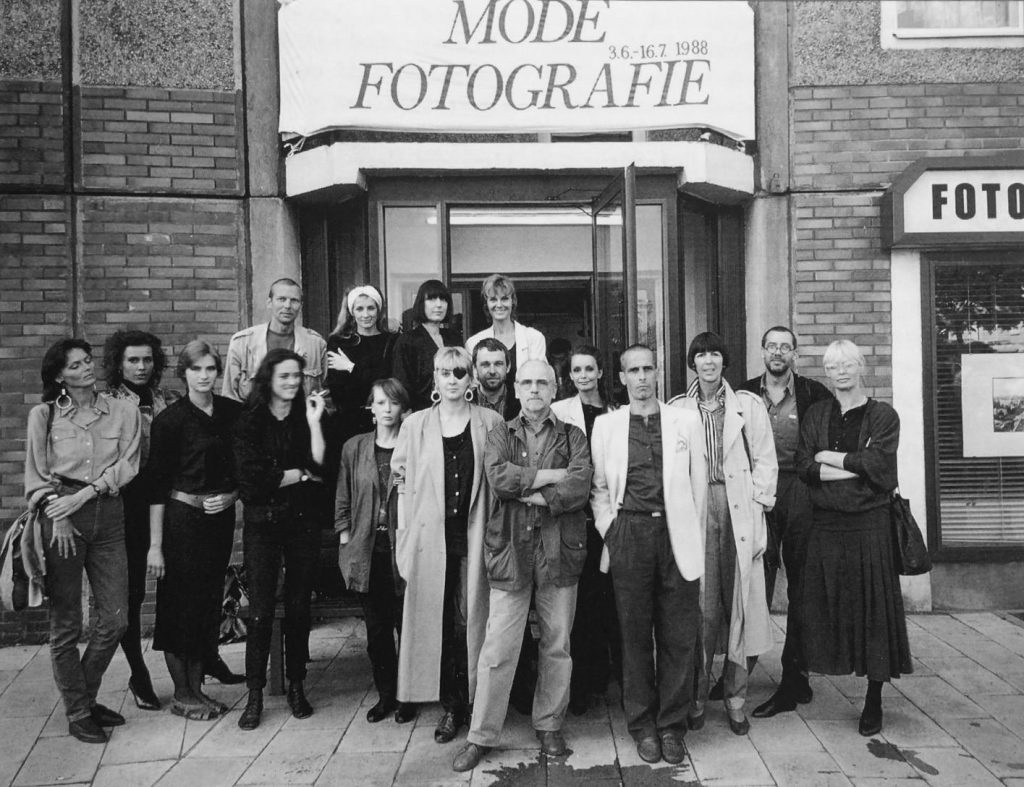History
 (c)Harf Zimmermann, group photo for the exhibition ‘Three decades of fashion photography’, Fotogalerie June 1988. In the foreground, four of the main characters of German photography, from left to right: Sybille Bergemann, Ute Mahler (with eye patch), Arno Fischer, Roger Melis.
(c)Harf Zimmermann, group photo for the exhibition ‘Three decades of fashion photography’, Fotogalerie June 1988. In the foreground, four of the main characters of German photography, from left to right: Sybille Bergemann, Ute Mahler (with eye patch), Arno Fischer, Roger Melis.
Fotogalerie Friedrichshain was the first art gallery in former East Germany that focussed exclusively on photography. One of the true pioneers of photography in Europe founded in 1985, it is located just between Warschauer Straße station and famous Berghain club. During its moving 30 years history, it hosted exhibitions by the likes of Sebastiao Salgado, Tina Modotti, Imogen Cunningham, Gordon Parks or Cecil Beaton, along legendary German photographers like Helga Paris, Arno Fischer, Sybille Bergemann, Roger Melis, Harald Hauswald or Ute Mahler.
1981–1984 (planning phase)
In the late 1970s, East Berlin art students Ralf Herzig and Ulrich Domröse had the vision of an art gallery focussing exclusively on photography – a concept that rarely existed in Germany at that time. Since private enterprises were not welcomed in socialist GDR, Herzig and Domröse approached the cultural administration of East Berlin to present their innovative gallery project. This coincided with the district Friedrichshain’s plans to open a municipal art gallery in a new Plattenbau on Helsingforser Platz near Warschauer Straße, just a few steps away from the Berlin Wall. After years of negotiations about the artistic concept, architecture and precise room design, the responsible politicians finally agreed to open the official district gallery of Friedrichshain as a place exclusively devoted to photography.
1985–1989
The gallery celebrated its opening on 28th August 1985 with an exhibition of Richard Peter, who impressively documented the devastating destruction of Dresden towards the end of World War II.

At that point, founder Ralf Herzig had already left Fotogalerie because he had been classified as “politically instable” and was not offered a satisfying job in the place that he created. Ulrich Domröse, too, left the gallery after he curated the first four exhibitions because he disagreed with the director of Fotogalerie, Heidrun Dauert. However, the gallery with its 200m² exhibition space and bar area immediately became very popullar – up to 50.000 visitors per year underline the importance and uniqueness of this project in the 1980s. The photographers themselves were essentially responsible for this early success, creating the first hub for photography in East Berlin but also forging a lively exchange with western artists that crossed the border. Photographers Roger Melis, Peter Leske and Werner Maler were particularly engaged, along with publisher Wolfgang Kil.
1990–2002
After the fall of the Berlin Wall, more and more West German and international visitors and artists came to the gallery thanks to the open borders. World-famous photographers like Sebastiao Salgado or Gordon Brown had solo exhibitions at Fotogalerie in the early 1990s. However, due to restructuring processes after reunification, the district of Friedrichshain faced serious financial difficulties that also affected the municipal gallery. Ever since that period, public funding decreased and Fotogalerie somehow lost its unique position in the world of photography as new art spaces rapidly emerged in reunited Berlin, creating the cultural diversity that the city is famous for today.
2002 – Today
In 2002, the district finally decided that it could not maintain the gallery any more and Fotogalerie was seriously threatened by closure. The district decided to collaborate with the cultural non-profit organisation Kulturring in Berlin e.V. to ensure the opening. From that moment on, Kulturring has been fully responsible for the Fotogalerie Friedrichshain, collaborating with an advisory board of photographers and art experts. Today, the gallery can pride itself with more than 31 years of continuous exhibitions, always focussing on engaged photography. Single exhibitions of renowned photographers like Harald Hauswald or Danila Tkachenko alternate with group exhibitions of upcoming artists. The majority of collaborating artists use analogue photography and understand their work as a craft, often producing all prints in their own photo lab.
In August 2015, Fotogalerie Friedrichshain celebrated its 30th anniversary with a retroperspective. Along with various photographers that shaped the gallery throughout the years, founder Ralf Herzig officially returned to the gallery for the first time since 1985.

Ralf Herzig, second from left, 2015. Photo: B. Richter
More interesting history around the Helsingforser Place and the Photo Gallery is on the side of Friedrichshainer ZeitZeiger
